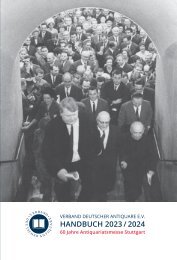Antiquariatsmesse Stuttgart 2021 - Katalog
Katalog zur Antiquariatsmesse Stuttgart 2021: Die Antiquariatsmesse Stuttgart als größtes Schaufenster für wertvolle Objekte des Antiquariats- und Graphikhandels in Deutschland findet in diesem Jahr in ungewohnter Form statt. Da eine Präsenzmesse nicht stattfinden kann, haben sich 76 Kollegen aus Deutschland, Großbritannien, Österreich, Frankreich, der Schweiz, den Niederlanden, den Vereinigten Staaten und aus Australien zusammengefunden, um einen Katalog für die Messe zu erstellen und gleichzeitig ein Angebot für eine virtuelle Messe zusammengetragen. Der Katalog wird am 7. Januar 2021 an interessierte Kunden verschickt, die virtuelle Messe öffnet ihre „digitalen Pforten“ am 29. Januar 2021 um 12.00 Uhr unter www.antiquariatsmesse-stuttgart.de
Katalog zur Antiquariatsmesse Stuttgart 2021: Die Antiquariatsmesse Stuttgart als größtes Schaufenster für wertvolle Objekte des Antiquariats- und Graphikhandels in Deutschland findet in diesem Jahr in ungewohnter Form statt. Da eine Präsenzmesse nicht stattfinden kann, haben sich 76 Kollegen aus Deutschland, Großbritannien, Österreich, Frankreich, der Schweiz, den Niederlanden, den Vereinigten Staaten und aus Australien zusammengefunden, um einen Katalog für die Messe zu erstellen und gleichzeitig ein Angebot für eine virtuelle Messe zusammengetragen.
Der Katalog wird am 7. Januar 2021 an interessierte Kunden verschickt, die virtuelle Messe öffnet ihre „digitalen Pforten“ am 29. Januar 2021 um 12.00 Uhr unter www.antiquariatsmesse-stuttgart.de
Sie wollen auch ein ePaper? Erhöhen Sie die Reichweite Ihrer Titel.
YUMPU macht aus Druck-PDFs automatisch weboptimierte ePaper, die Google liebt.
English Bible Manuscript
[Biblia latina]. Latin manuscript on vellum. Northern
France or England?, ca. 1300. 4to (150 × 195 mm).
440 ff. (quires: a–f 16 , g 18 , h–x 16 , y 12 , zA–D 16 , E 10 ; recent
pencil foliation). 55 lines, 2 columns (written
space ca. 75 × 125 mm). Miniscule gothic bookhand
in blank ink; emphases in red, page captions, chapter
numbers, rubrication and Lombardic initials in
red and blue, numerous red and blue initials with
elaborate penwork in complementary colours. 16th
century auburn morocco on four raised double
bands, gilt spine ornaments, both covers with fleurons
to corners, multiple rules along the edges, and
gilt coat of arms (quarterly, a goat rampant and a
sheaf of corn; inescutcheon a lion rampant; not in
Olivier), dated “1587” on upper cover. 4 modern
cloth ties. Stored in custom-made half morocco
case. € 175 000,–
A beautiful, complete mediaeval Bible written in a miniscule
bookhand on extremely delicate vellum, probably
copied in England or commissioned from there.
As is common, the Bible is prefaced with the epistle
of St Jerome to Paulinus (53: “Frater Ambrosius […]
moriturum”, fols. 1 r –3 r ), followed by Jerome’s prologue
to the Pentateuch (“Desiderii mei […] in latinum
eos transferre sermonem. Amen”); the text of Genesis
begins on fol. 4 r . The Second Book of Kings is followed
by the Book of Isaiah (139 v ) and the Prophets; on fol.
227 r follow the Book of Job and the Poetic Books; 287 v
ff. contain the Books of Chronicles and the historical
books to 2 Maccabees; the New Testament begins on
fol. 351 r .
Some page headings and penwork flourishes slightly
trimmed, still an uncommonly wide-margined specimen.
Occasional flaws in the vellum were carefully
avoided by the scribes. The margins contain numerous
contemporary and later annotations in what appear to
be four different hands (a number of which are also
very slightly trimmed), some exceedingly delicate: one
8-line annotation measures no more than 10 mm! The
early marginalia would appear to be in a 15th century
English hand; at least one (at the lower edge of fol. 41 v )
is an extract from the Psalm commentary of the Yorkshire
mystic Richard Rolle (d. 1349). Furthermore, the
plummet lines along many of the earliest marginalia, but
also the order of the Old Testament Books, uncommon
for a French Bible, suggest an English provenance. As
the continental hands of the later annotations show,
the Bible must have reached France or Germany in the
later 15th century.
Professional repairs to spine-ends and one corner of
the fine Renaissance binding. First and last quires a little
browned and dust-stained, very slight worming to
beginning, occasional, largely insignificant waterstains
to margins, a few edge cuts and cut-out sections in
the blank margins. An old edge repair to fol. 155, fols.
310–323 as well as a few others more strongly browned
and wrinkled, but generally in fine state of preservation.
– Provenance: Karl & Faber, sale 81 (1962), no. 3.
125






